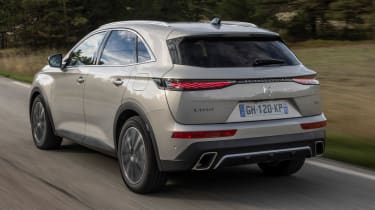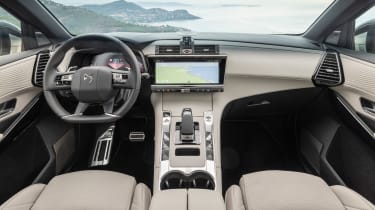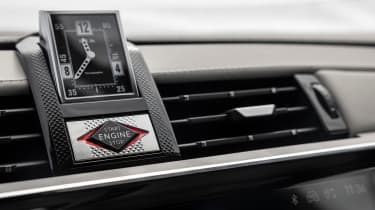New DS 7 225 Performance Line+ 2022 review
DS has done a good job of improving its mid-size SUV in multiple areas, but old complaints remain
Verdict
The exterior and interior changes have improved the DS 7 225 noticeably, and the extra range from the enlarged battery is nice to have. It’s a shame that DS has left the suspension of all but the new range-topping 360 model alone, though, as the ride remains an issue. It’s not cheap, either.
When the DS brand was spun off from Citroen as a standalone affair, its new format began rather inauspiciously. The first new DS models were merely former Citroens with the famous chevron badging removed, and once the first bespoke model - the DS 7 - came along, we weren’t exactly bowled over. While great-looking and very roomy, its pricing pitted the SUV against much more talented rivals.
Since then, though, DS has been making some good steps in the right direction in its quest to take on the premium car elite. The DS 4 launched last year and is the brand’s most impressive car to date, offering a package that’s truly different from anything else in the class. The DS 7 received a boost too in the form of the plug-in hybrid model, which impressed us on a long-term test much more than the standard version.
Now, there’s a facelifted DS 7 Crossback, and its mid-life refresh is far from a minor nip and tuck. The exterior changes are immediately obvious, particularly at the front. Here, there’s a larger grille, under which is a dramatic new LED daytime running light design featuring four lit vertical strakes on either side of the bumper. The headlights are refreshed too, now featuring DS’s more effective ‘Pixel LED Vision 3.0’ technology.
More reviews
Car group tests
- Abarth Punto vs Corsa SRi
- Alfa Romeo Tonale vs Volvo XC40: 2023 twin test review
- Alpina XD3 Biturbo vs Porsche Macan S Diesel
- The best long-term car tests 2022
- BMW M2 CS vs Porsche 718 Cayman GTS vs Alpine A110 S
- Audi TTS vs Alpine A110 vs Porsche 718 Cayman
- Ariel Nomad
- Aston Martin DB11 AMR vs Bentley Continental GT
- Audi RS and performance mega test: historic Audi sports cars head-to-head
- BMW 5 Series vs Audi A6 vs Volvo S90
- The best long-term car tests 2022
- The best long-term car tests 2022
- The best long-term car tests 2022
- The best long-term car tests 2022
In-depth reviews
- Abarth 124 Spider review
- Abarth Punto (2008-2015)
- Alfa Romeo Giulia review
- Alfa Romeo Tonale review
- Alpina XD3 Biturbo
Long-term tests
- Alpine A110 GT: long term test review
- Citroen Ami: long-term test review
- Cupra Born V3: long-term test review
- Dacia Jogger: long-term test review
- DS 4 E-Tense 225: long-term test review
- Fiat 500: long-term test review
- Jaguar F-Pace PHEV: long-term test review
- Land Rover Defender P400e PHEV: long-term test review
- Mazda CX-60 PHEV: long-term test review
- Mazda CX-5 diesel: long-term test review
Road tests
- New AC Cobra 378 Superblower 2021 review
- New AC Cobra 378 review
- New Alfa Romeo Stelvio 2023 review
- New Alfa Romeo Giulia 2023 review
- New Alfa Romeo Tonale PHEV 2023 review
- New Alfa Romeo Tonale 2022 review
- New Alpina B3 Touring 2023 review
- New Alpine A110 R 2023 review
- New Alpine A110 S 2022 review
- New Alpine A110 Legende GT 2021 review
Used car tests
- Used Alfa Romeo 4C (Mk1, 2014-2019) review
- Used Aston Martin DB9 (2004-2016) review
- Used Audi A4 review
- Used Bentley Continental GT (Mk3, 2018-date) review
- Used Bentley Continental GT (Mk2, 2010-2018) review
- Used Fiat 500 review
- Used Honda CR-V (Mk4, 2012-2017) review
- Used Lexus ES (Mk7, 2018-date) review
- Used Lotus Elise review
- Lotus Elan M100: Buying guide and review (1989-1996)
At the other end, the outgoing car’s rounded rump is replaced with a much more angular design thanks to an abundance of new creases. The light clusters are a little slimmer, and the ‘Crossback’ lettering has been replaced with new ‘DS Automobiles’ script.
The irony of this fairly major cosmetic surgery is that the looks of the existing DS 7 were one of its stronger suits. But thankfully, the changes are much more than skin deep. For starters, the battery capacity has gone up from 13.2kWh to 14.2kWh, yielding an additional six miles of range. In this E-Tense 225 model, that means up to 43 miles of electric-only range on paper, which in reality should make a figure in the low to mid-thirties plausible.
There are more choices in terms of colours and finishes in the cabin, with some of the leather embossings on offer being particularly stylish. There’s also a new 12.3-inch digital instrument cluster and a fresh 12-inch touchscreen infotainment system.
The rotating ‘timepiece’ from French watchmaker B.R.M remains, as does a general air of glitziness. It’ll be a little too much for some, but as with other cars in the DS range, we appreciate that the 7 offers something genuinely different from the more obvious German premium options.
Unfortunately, the only car in the range to have any suspension work done is the new range-topper, the E-Tense 360. DS Performance has thrown the kitchen sink at it, with alterations including an increase in front and rear track widths plus a lower ride height with new springs and dampers. All others, including the E-Tense 225 we’re testing here, make do with the old set-up.
That’s a problem, as the DS 7 has long needed its inconsistent ride addressing. Sure enough, our test drive of the updated model soon revealed all the same issues as the outgoing car. The damping is soft, yes, but it lacks control, meaning the DS 7 feels flustered when negotiating speed bumps and imperfections in the road surface.
It comes down to earth with a lot of fuss, rather than ironing out potholes and broken-up tarmac, and that’s despite the presence of DS Active Scan suspension (standard on all E-Tense plug-in hybrids), which is supposed to monitor the road ahead and prepare the adaptive dampers as necessary. We also sometimes found the car awkwardly shimmying on some parts of the test route. Some of the ride problems can be mitigated on the configurator - our car had the optional 20-inch wheels, which we’d eschew for the standard-fit 19s.
On twistier roads, the DS 7 is as tidy as it needs to be. The body stays relatively level, and traction levels are reasonable. It doesn’t take much effort to push the front end into understeer, but it’s hard to imagine many DS 7 drivers wanting to carve up a country road with much enthusiasm. Should they want to, there’s always the E-Tense 360 to consider, although that does come at quite a cost.
When you’re on a smoother road, such as a motorway, the ride does settle, for the most part, allowing you to enjoy the DS 7’s refinement and enhanced interior ambience. When the suspension is a little less busy, the DS 7 is relaxing to drive, with low levels of wind and road noise plus an attractive and well-built cabin to enjoy.
The new infotainment system is a particularly welcome addition. The graphics look crisp, the touchscreen is reasonably responsive and it’s helpful to have a view which combines the map with the climate controls, as the shortcut keys along the bottom of the screen bezel make flicking between functions on the move a little tricky.
As before, the 225 uses a 1.6-litre inline four-cylinder engine combined with a front-mounted electric motor, making for a total output of 222bhp and 360Nm. With a 0-62mph time of 8.9 seconds, it’s no rocketship, but the 225 doesn’t feel slow either. For most, it’ll provide enough performance. The eight-speed automatic gearbox is smooth enough, too. We’d like the transitions from electric-only running to hybrid to be a little slicker, however.
Despite the presence of a bigger battery, you get just as much space inside the refreshed DS 7. That means impressive rear leg and headroom, plus a roomy 555-litre boot, expanding to 1,752 litres with the rear seats folded. There’s also a useful space under the boot floor for a charging cable.
There’s no such thing as a cheap DS 7, with the range starting at around £37,000 for the sole diesel option. The rest of the line-up are plug-in hybrids, the cheapest of which - an E-Tense 225 in entry-level Performance Line trim - is over £44,000. At the other end of the scale is the Opera Premiere E-Tense 4x4 360, yours for close to £63,000.
Our 225 Performance Line+ weighs in at £47,000. For that, you’re getting a reasonable standard kit list including keyless entry, electric and heated front seats, the new digital instrument cluster/infotainment combo, a reversing camera and a heated windscreen. Our car had the optional 14-speaker Focal Electra sound system, which is excellent but costly at £990.
| Model: | DS 7 225 Performance Line+ |
| Price: | £46,890 |
| Engine: | 1.6-litre 4cyl petrol + 1x e-motors/14.2kWh battery |
| Power/torque: | 222bhp/360Nm |
| Transmission: | Eight-speed automatic, front-wheel drive |
| 0-62mph: | 8.9sec |
| Top speed: | 140mph |
| Fuel economy: | 201mpg |
| CO2: | 31g/km |
| On sale: | 28 September |








